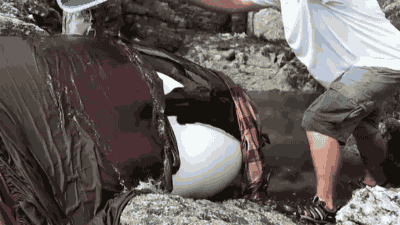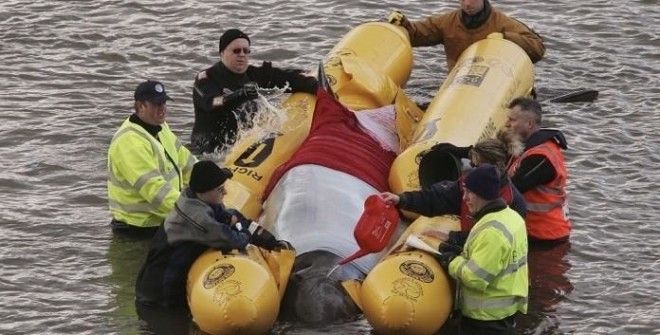Thousands of whales and dolphins get stranded, entangled, or beach themselves each year. And while this story has a happy ending, many animals aren't so lucky.

"Recalculating..." The stranded orca on the rocks in Hartley Bay.
To learn more about how and why incidents like this happen and what animal lovers can do to help, I spoke with Steve Whitehouse of Queensland, Australia, who is the stranding rescue and technical adviser for Whale Rescue.
There are lots of reasons whales strand themselves. Sometimes, it's as simple as taking a wrong turn.
Whales strand for a host of reasons, including illness or navigational errors. They may misread the height of the rocks or the depth of the shore while swimming.
"This orca? [She] was probably just chasing fish. It's quite a common scenario," Whitehouse told me.
Windy weather, loud noises, and echolocation glitches can also result in strandings. Rescuers have to be careful though, because if a pod leader separates from the group, others will follow.
This can sometimes lead to a mass stranding.

Whitehouse and his partner Brenda at the scene of a mass stranding at Farewell Spit, South Island New Zealand in February. 69 pilot whales came ashore. 67 were re-floated and saved. Photo by Steve Whitehouse for Whale-Rescue.org.
When whales are beached or stranded, trained professionals and volunteers help by keeping the animals cool and calm.
According to Whitehouse, every rescue is unique, but each one centers on getting the animal re-floated safely.
In the case of the stranded orca in Hartley Bay, whale researchers and volunteers covered the orca with wet blankets and kept her hydrated with buckets of chilly water. They stayed by her side, keeping her cool and calm, for eight hours!

Volunteers pour cold water on the orca to keep her calm and cool.
When the tide comes in, some whales are able to free themselves, while others need a little boost. With help from the volunteers and a nudge from high tide, the orca in Hartley Bay was successfully able to wriggle free from the rocks. She gave a spray of appreciation and joined her pod in the distance.

But other stranding situations are a little more complicated.32 years ago, Whitehouse designed an inflatable whale rescue pontoon. The unique vessel is a modular device consisting of a mat and two inflatable tubes.
"It's like a big set of water wings," he told me.

Whitehouse's device in use rescuing pilot whales in New Zealand.
When used by rescue workers, the device simulates high tide, by gently lifting the whale up so it can be re-floated safely.
Whitehouse's invention is used in 14 countries and has saved thousands of animals. "Its become standard equipment now," he said.

Whitehouse's inflatable pontoon was used to rescue a stranded whale that made his way to the River Thames in London.
If you see a stranded marine animal, the best thing you can do is call a professional or rescue group with your location.
Until an expert can assess the situation, it's safer for you and the animal if you stay at least 50 feet back and call in the location of the creature in distress.
If you must assist, foster a heartwarming relationship with the whale, teach him to perform tricks, and help him triumphantly return to the sea 72 minutes later. At least, that's what "Free Willy" taught me, and movies never lie.

Of course, I'm kidding. Many of these creatures are endangered or at risk, so every minute counts. If you see a stranded marine animal, just call your local stranding hotline as soon as possible.

